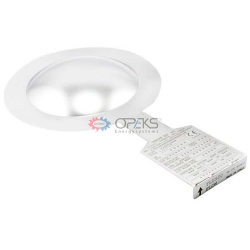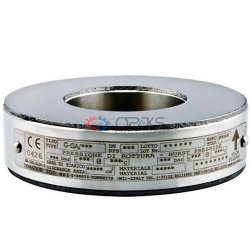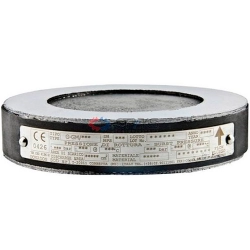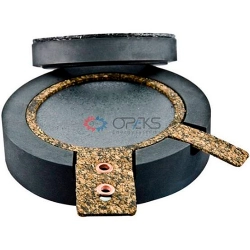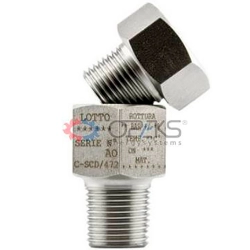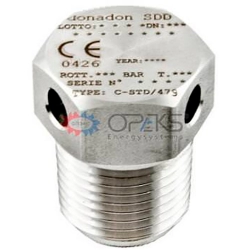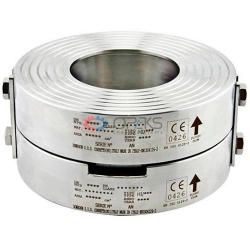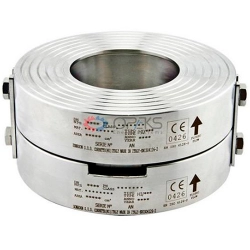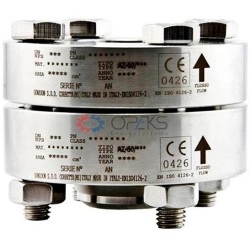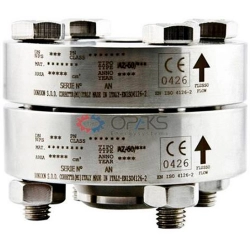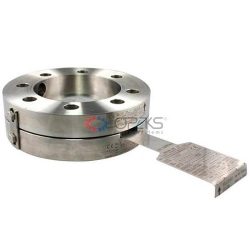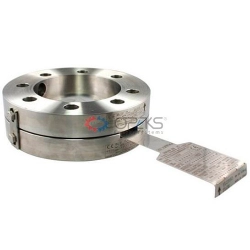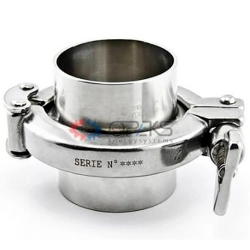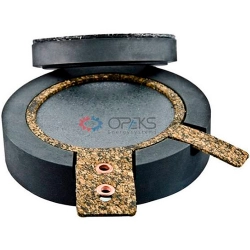Safety bursting discs
 Rupture disc LESER KUB
Rupture disc LESER KUB
- Manufacturer: LESER
- Model: KUB
- Nominal inlet: DN25-DN400
- Response pressure: 0.6-120 bar
- Working environment temperature: -30 to 550 °C
- Material: 1.4404; 1.4401; 1.4435; 1.4571; Nickel, Inconel®; Monel®; Hastelloy® (C4); Titan; Tantal
 Rupture disc DONADON SDD KRD
Rupture disc DONADON SDD KRD
- Manufacturer: DONADON
- Model: KRD
- Nominal inlet: DN 1”(25)-DN 36”(900)
- Response pressure: 0.41-137 bar
- Working environment temperature: -196 to 480 °C
- Material: Stainless steel; Alloy 201; Alloy 400; Alloy 600; Alloy C276; Titan; Tantal
 Rupture disc DONADON SDD SCD
Rupture disc DONADON SDD SCD
- Manufacturer: DONADON
- Model: SCD
- Nominal inlet: DN 1”(25)-DN 36”(900)
- Response pressure: 2-413 bar
- Working environment temperature: -196 to 480 °C
- Material: Stainless steel; Alloy 201; Alloy 400; Alloy 600; Alloy C276; Titan; Tantal
 Rupture disc DONADON SDD SCR
Rupture disc DONADON SDD SCR
- Manufacturer: DONADON
- Model: SCR
- Nominal inlet: DN 1”(25)-DN 36”(900)
- Response pressure: 0.41-137 bar
- Working environment temperature: -196 to 480 °C
- Material: Stainless steel; Alloy 201; Alloy 400; Alloy 600; Alloy C276; Titan; Tantal
 Rupture disc DONADON SDD Y90
Rupture disc DONADON SDD Y90
- Manufacturer: DONADON
- Model: Y90
- Nominal inlet: DN 1”(25)-DN 8”(200)
- Response pressure: 0.2-70 bar
- Working environment temperature: -196 to 480 °C
- Material: Stainless steel; Alloy 201; Alloy 400; Alloy 600; Alloy C276; Titan; Tantal
 Rupture disc DONADON SDD DCD
Rupture disc DONADON SDD DCD
- Manufacturer: DONADON
- Model: DCD
- Nominal inlet: DN ½”(15)-DN 40”(1000)
- Response pressure: 0.01-110 bar
- Working environment temperature: up to 480 °C (PTFE/PFA diaphragm max 265 °C)
- Material: stainless steel; Alloy 201; Alloy 400; Alloy 600; Alloy C276; Titan. Diaphragm: PTFE, PFA, stainless steel, aluminum
 Bursting disc DONADON SDD DIF
Bursting disc DONADON SDD DIF
- Manufacturer: DONADON
- Model: DIF
- Nominal inlet: DN ½”(15)-DN 40”(1000)
- Response pressure: 0.5-5 bar
- Working environment temperature: up to 480 °C (PTFE/PFA diaphragm max 265 °C)
- Material: stainless steel; Alloy 201; Alloy 400; Alloy 600; Alloy C276; Titan. Diaphragm: PTFE, PFA, stainless steel, aluminum
 Bursting disc DONADON SDD LPD
Bursting disc DONADON SDD LPD
- Manufacturer: DONADON
- Model: LPD
- Nominal inlet: DN 2"(50)-DN 20”(500)
- Response pressure: 5-500 mbar
- Working environment temperature: up to 265 °C
- Material: stainless steel; Alloy 201; Alloy 400; Alloy 600; Alloy C276; Titan. Membrane: PTFE, PFA
Shown 8 from 23
show all
 Individual heating station of the heating system according to an independent connection scheme
Individual heating station of the heating system according to an independent connection scheme
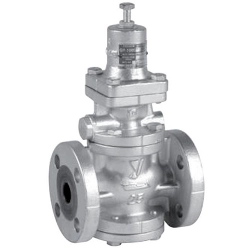 Reducing valve for steam Yoshitake GP-1000EN
Reducing valve for steam Yoshitake GP-1000EN
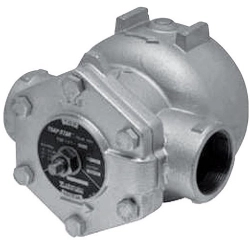 Float steam trap Yoshitake TSF-10
Float steam trap Yoshitake TSF-10
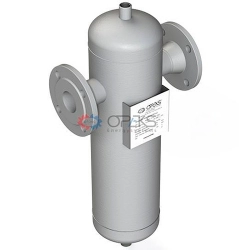 Centrifugal steam separator OPEKS-1-SC16-1-F50
Centrifugal steam separator OPEKS-1-SC16-1-F50
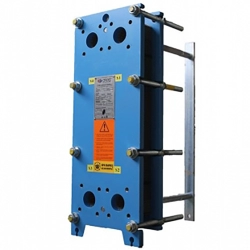 Plate heat exchanger THERMAKS РТА (GC)-16
Plate heat exchanger THERMAKS РТА (GC)-16
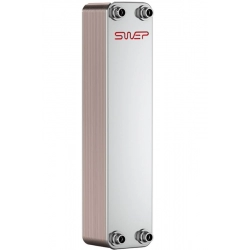 Brazed heat exchanger SWEP B25T
Brazed heat exchanger SWEP B25T
 Brazed heat exchanger SWEP B25THx20
Brazed heat exchanger SWEP B25THx20
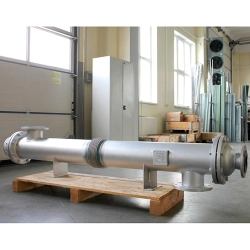 Shell and tube coolers
Shell and tube coolers
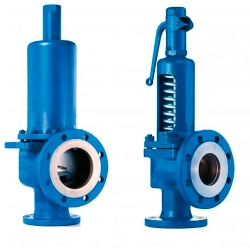 Safety valve LESER 441/442
Safety valve LESER 441/442
Bursting discs
Emergency situations on hydraulic or steam-gas systems associated with a significant excess of the maximum allowable pressure, or the occurrence of a strong vacuum (vacuumization) in them are by no means uncommon. Such an unacceptably high or evacuating pressure can compromise the integrity and tightness of the system, damage the existing equipment.
Hydraulic and gas-dynamic machines (pumps, pumps, compressors, boilers, gas and hydraulic cylinders, hydraulic motors, steam-gas turbines, etc.), capacitive or heat exchange equipment are already very valuable and expensive units in themselves. But their damage, premature failure can generate even more massive losses associated with the shutdown of entire technological processes and production. In some cases, such emergencies can lead to real man-made or environmental disasters.
What is a safety diaphragm
As you know, in electrical engineering, fuses are used to protect electrical circuits from overloads. In hydraulic and steam-gas technical systems, such "fuses" are membrane safety devices (PMU).
PMU are devices with structurally programmed destruction of partitions - membranes under the influence of a certain (standard) value of pressure acting from the side of the medium (zone) of high pressure towards the medium (zone) of low pressure. Thus, PMU is a type of safety valves designed to protect hydraulic and steam-gas systems from the destructive (emergency) consequences of excess or vacuum pressure, which works by its own destruction necessary to dump the mass of the working medium (towards the waste system).
The ruptured diaphragms better resist the processes of corrosive action, polymerization or crystallization of the working medium better than the safety valves, provide complete tightness (until they are triggered) and do not limit the throughput of a closed gas or hydraulic system. This means that they more reliably ensure the safety of the protected work equipment. An important advantage of PMU over valves is also the extreme simplicity and low cost of their design.
The main disadvantage of using PMU is that in the event of their operation, the entire or almost all volume of the technological environment is discharged from the system, which often represents a very significant material value, or a great danger to workers and the environment.
Destructive PMU membranes are: bursting, “flapping”, breaking, shear, tear-off. But in the process of development of technology, from the list of membrane safety devices, those that give a wide range of response pressure and do not provide the necessary degree of equipment protection are gradually becoming obsolete. Such unreliable safety devices include obsolete: breakable, shear and tear-off diaphragms. At the present stage of development of technology, the most widespread are safety devices with bursting and “popping” membranes, which give the best results in terms of accuracy and response speed.
Bursting disc
The bursting type (direct acting) diaphragm, working in tension, is designed to break (act) by rupture under the influence of a certain rate of high (or low vacuum) pressure of the working medium.
A bursting disc is usually an element of thin-walled sheet material, fixed in a housing (cage) at the interface between a high-pressure zone (usually a working medium) and a low-pressure zone (relief system). It can have both a flat and a curved hemispherical (dome-shaped) surface. The direction of bending of the bursting disc dome is in the direction opposite to the zone of increased pressure (in the direction of the relief system).
The principle of operation of the bursting disc is quite simple - when the pressure of the working medium approaches the limit value, it, under its influence on its surface, begins to stretch, and completely ruptures at its limit value. As a result, the working medium is discharged through the ruptured membrane into the relief system, and the emergency pressure in the equipment drops to permissible values.
Bursting discs can be either solid or with notches (radial, circular), which facilitate their rupture when the set pressure is reached. In addition, for systems with varying operating pressures, a vacuum support (usually a cruciform) can be introduced into the rupture disc design. It protects the abnormal destruction of the membrane during the evacuation of the working equipment, that is, when such a vacuum is formed inside it, when the bursting disc can burst inward, under the influence of the pressure of the relief system, which in such a situation becomes a high pressure zone.
Bursting PMUs have acceptable accuracy and response speed, allow to bring the working pressure in the apparatus up to 80% of the ultimate strength of the safety membrane. They can be used for both liquid and gas environments, work with static, alternating, pulsating pressures.
Bursting discs are manufactured:
- from rolled sheet metal of ductile metals (aluminum, copper, nickel, brass, silver, monel (Ni + Cu), inconel (Ni + Cr + Fe), tantalum and others);
- from polymer (teflon, fluoroplastic, polyethylene) sheets and films;
- for systems with highly aggressive media - from graphite impregnated with phenolic resins;
- for systems with low working pressures - even made of paper, cardboard, poronite, asbestos.
The only disadvantage of bursting discs is that they are inferior to the "clapping" ones in terms of the main parameters (speed and accuracy of operation). The reason is that they have some response delay caused by the stretching process of the membrane material before its complete destruction (rupture).

Rice. Bursting disc diagram
Flapping membrane
The version of the “flapping” membrane differs from the bursting version in that it works not in tension, but, on the contrary, in compression. For this, the dome of its hemisphere is directed towards the high-pressure zone, that is, inside the protected equipment.
The principle of operation of the "flapping" membrane is as follows. When the pressure in the apparatus is higher than the critical one, it presses on the dome of the hemisphere of the membrane, crushes it and "turns" in the opposite direction. In this case, the following response options are possible:
- if the design of the membrane is open-ended, then it loses its stability and instantly "pops out" ("pops"), completely jumping out of the cage;
- if the membrane has a "pinched" contour, then the membrane dome, turned inside out, hits the blade of a fixed cruciform knife (which is provided by the design) and is destroyed by it.
"Flapping" membranes also have an extremely simple design, can be used for liquid and gas media, work with static, alternating, pulsating pressures. But unlike discontinuous ones, they do not have a period of stretching of the material before its destruction, therefore they have an advantage over them in terms of accuracy and response speed. Moreover, the “flapping” PMU allow to bring the operating pressure in the system up to 95% of the limiting level (for the strength of the safety diaphragm). Other important benefits of the flapping design are:
- absence of fatigue stretching, due to which the membrane has a longer service life;
- it does not require a vacuum support;
- it is possible to use a thicker-walled material, which increases its corrosion resistance in chemically aggressive environments.
A known disadvantage of "flapping" membranes is their high sensitivity to damage, even minor dents of the dome, obtained at the stages of transportation, storage, installation, or during maintenance (repair) of equipment.

Rice. Flapping safety diaphragm diagram
In the presence of pressure surges (counteraction) from the side of the relief system, which can violate the standard conditions for the operation of the PMU, the bursting and “flapping” PMU are equipped with an auxiliary membrane, forming new structural subspecies:
- bursting PMU with an auxiliary diaphragm;
- flapping PMU with an auxiliary membrane.
In such constructional variants, an intermembrane space is formed, in order to control the pressure in which a signal pressure gauge is additionally introduced into the PMU structure.
Installation diagrams of safety diaphragms
Diaphragm safety devices in the working system can be installed both independently and in combination with safety valves.
Independently (without safety valves) MPUs are installed:
- in systems with rapid pressure surges, in which the safety valves, due to their inertia, cannot provide the response speed required to protect the equipment;
- to protect containers from hazardous overpressure or vacuum pressure.
Before the MPU safety valves are installed:
- to provide the ability to adjust and maintain valves without removing them from the equipment;
- in situations where there is a risk of disruption of the normal operation of the valve (or its complete jamming) due to the harmful effect of the working environment on its parts (corrosive oxidation, coking, "sticking", freezing, crystallization, polymerization, etc.).
Parallel to the MPU safety valves, they are installed to increase the throughput of the discharge system. This option is used when a safety valve of a small bore diameter serves as a "standby" valve to relieve the increased pressure, which has not yet reached the emergency value, and the PMU "enters into action" already in a real emergency.
The following are installed behind the PMU safety valves:
- in situations where the reliability of the valve mechanism can be impaired by the harmful effects of the environment (waste system), for example - corrosive oxidation, icing, the influence of the "human factor", etc .;
- in order to exclude the influence on the operation of the valves from the counter (pressure fluctuations) of the relief system.
Rupture disc installation requirements
Safety membranes, including imported ones, can be approved for installation and operation only with the appropriate permission issued by Gostekhnadzor.
For the admission of the MPU to operation at enterprises (organizations), on the basis of the manufacturer's instructions, operational documents approved by their managers must be developed. The permit of the MPU for operation must be formalized by an appropriate act.
If the final assembly of a batch of MPUs is carried out at the enterprise (in the organization), then at least one product must be tested for compliance with the required operating conditions.
Specifications for the selection of bursting disc
In order to select a safety PMU for a certain hydraulic or steam-gas system, you should know and take into account a number of its technical characteristics. Their list includes:
- type of working medium (gas or liquid), its chemical (corrosive) activity;
- nominal bore, depending on the required capacity of the discharge system, or in accordance with the parameters of the pipeline at the installation site;
- maximum operating temperature;
- required response pressure (maximum allowable pressure of the medium from the side of the working equipment);
- the nature of the pressure dynamics in the system: static, alternating or pulsating;
- the possibility of evacuation (rarefaction) in the system, and its parameters;
- maximum back pressure from the side of the discharge system and the nature of its dynamics.


